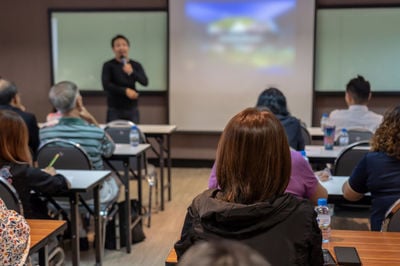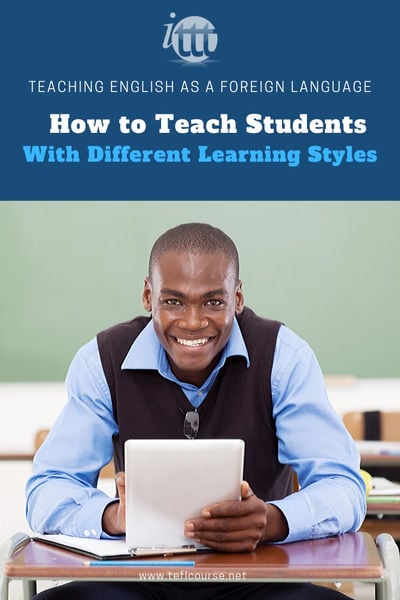How to Teach Students With Different Learning Styles

Jeremy Harmer, in his book How to Teach English, discusses different learning styles of students. He states that everyone responds to stimuli like photos, pictures, sounds, music, and movement, but that some things stimulate student learning more than other things do. Harmer cites Richard Bandler and John Grinder's neuro-linguistic programming theory which states that everyone has a preferred stimulus (e.g. visual, auditory, or kinesthetic) which they respond to above all others. Students who have a visual preference will remember things better if they see them. Those with an auditory preference are more likely to recall things they hear. Kinesthetic learners are influenced by activity and learn best when involved with some type of physical activity, such as moving around or rearranging items with their hands. Most students can respond to all types of stimuli, but one input method is typically more powerful than the others facilitating better learning and recall.
Table of Contents
TEACHING DIFFERENT LEARNING STYLES
Do you want to teach English abroad? Take a TEFL course!
This post was written by our TEFL certification graduate Wendy W. Please note that this blog post might not necessarily represent the beliefs or opinions of ITTT.
Since classrooms are made up of several different individuals with different learning styles and preferences, a skilled teacher will accommodate the needs of every learner by utilizing a variety of techniques. This paper will explore how to recognize each learning style as well as present teaching approaches specifically directed at each of the three learning styles - visual, auditory, and kinesthetic.
VISUAL LEARNERS
Visual learners are students with a preference for seeing and observing things. Students partial to learning through sight understand information better when it is presented visually. Pictures, diagrams, and written directions aid these students in learning and remembering information. This learning style is also sometimes referred to as the "spatial" learning style. To reach visual learners, the whiteboard should be utilized when teaching. Students should be allowed to draw pictures and diagrams on the board; teachers should regularly use presentations and make handouts upon which visual learners will doodle, take notes, and make lists.
One way of recognizing visual learners in the classroom is to listen to the type of language they use when they express themselves. Often these learners will respond to and use phrases such as, "I see what you mean", "I get the picture", "It appears to me," and "What's your view?" Some of the predicates chosen by visual learners include - appears, looks, bright, focus, viewpoint, clear, colorful, and hazy.

Also Read: Creating and Adapting Teaching Materials
AUDITORY LEARNERS
Auditory learners are those students with a preference for hearing and listening to understand information. Students partial to this style often learn and recall better when subject matter content is reinforced by sound. Lectures are this type of learner's best friend. They would much rather listen to an instructor or classmates' voice than to read written notes. They often will use their voices to read out loud to themselves, repeat instructor's words to reinforce new ideas, or sometimes sing about the new subject matter. Teachers can involve auditory learners by asking them to repeat back lecture information, by asking them questions and listening to their answers, and by providing them opportunities to talk in pair work or group discussion. These students enjoy the verbal exchange of group discussion so brainstorming, debates, telling stories, and using anecdotes cater to this type of learning style. Sound is critical to their learning process so watching videos, using music, or listening to audiotapes are also helpful ways teachers can engage those with an auditory preference.
Auditory learners can be recognized as the students who aren't afraid to speak up in class, who are talented at verbally explaining things, as well as those who find it difficult to remain quiet for long periods. These students use phrases like, "Sounds good to me", "I hear what you're saying", and "That rings a bell." Predicates chosen by auditory learners include - sounds like, tone, loud, rhythm, and resonates.

Also Read: Peculiarities of the English Language Every ESL Teacher Needs to Know
KINESTHETIC LEARNERS
Kinesthetic learners are those who prefer a "hands-on" approach and learn best by experiencing or doing things. These are the students who need to engage their bodies to understand concepts. They need to touch things with their hands, act out events with their bodies, or move their fingers when processing new information. Kinesthetic learners can often be seen flipping their pen, tapping their toes, and fidgeting with jewelry when deep in thought.
Students with a kinesthetic preference learn better with movement so any type of physical activity incorporated into classroom lessons will aid their comprehension and recall. For example, teachers can invite kinesthetic learners to use their hands to touch and handle objects as learning props, pace out a mathematical formula, or act out a story plot. Role-playing is an effective technique for these learners; even writing on the whiteboard is a physical activity that can increase learning for those with a kinesthetic preference.
When describing their thoughts and expressing themselves, these students will respond to and use phrases like, "It doesn't feel right", "I can't get my hands on that", "I need to get in touch with that", "How does that grab you?", or "I feel the connection." They also frequently say, "Let me try." The predicates most often used by kinesthetic learners are - feel, touch, grasp, solid, warm, cool.
Also Read: What is Teacher Self-Analysis and Why is it Significant for Student and Teacher Relationships?
TEACHING DIFFERENT LEARNING STYLES
Skilled teachers will incorporate a variety of classroom methods that meet the needs of each type of learner. Exceptional teachers will help the student identify their dominant preference and therefore equip the student with tools to improve their information acquisition and recall. Providing the student with the knowledge of how s/he processes and organizes their internal and external world based on visual, auditory, or kinesthetic stimuli empowers them for a life of learning, both in and out of the classroom.
Do you want to teach English abroad? Take a TEFL course!
Apply now & get certified to teach english abroad!
Speak with an ITTT advisor today to put together your personal plan for teaching English abroad.
Send us an email or call us toll-free at 1-800-490-0531 to speak with an ITTT advisor today.
Related Articles:
- The Top 5 Places to Teach English in Japan | ITTT | TEFL Blog
- 10 Questions You Need to Ask Before Enrolling In a TEFL Course
- Step-By-Step Guide To Legally Teaching English in South Korea
- Online or In-Class - Which TEFL Course Should You Take?
- Teaching English Abroad: What's Next? - How To Advance In Your EFL Career
- Teaching English In China - The Salary and Budget Guide




